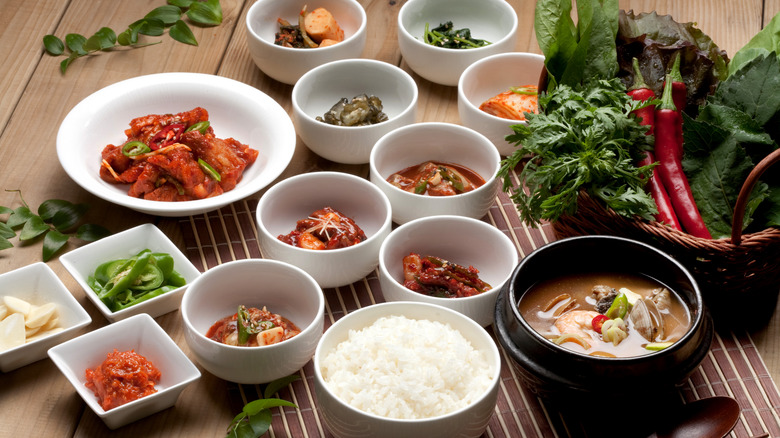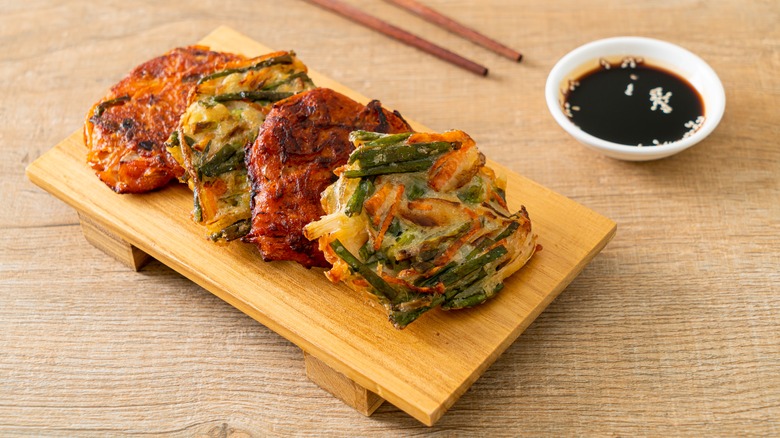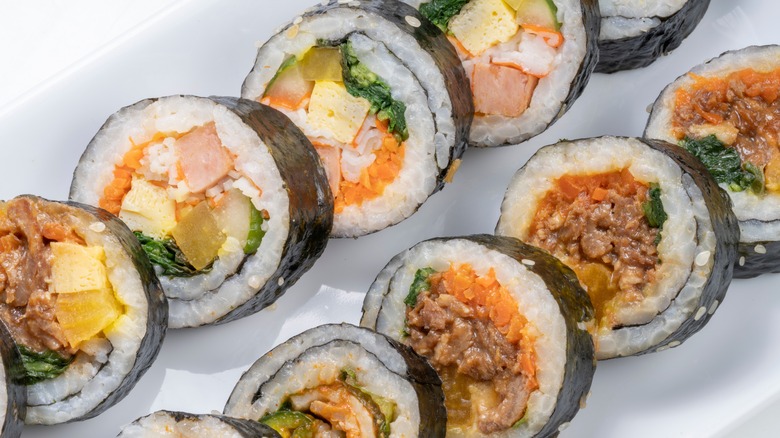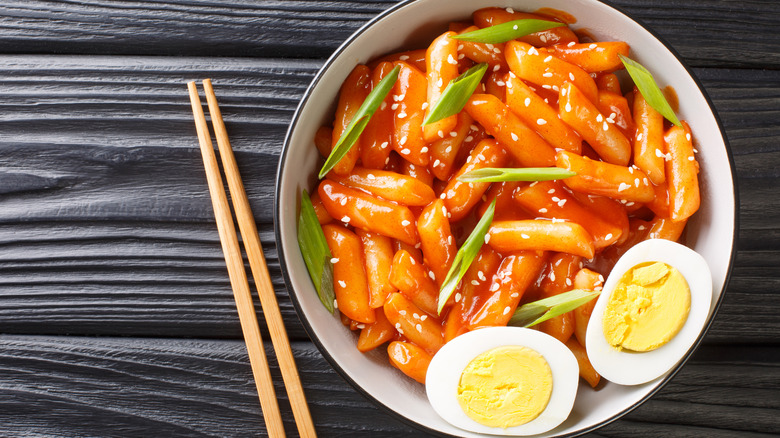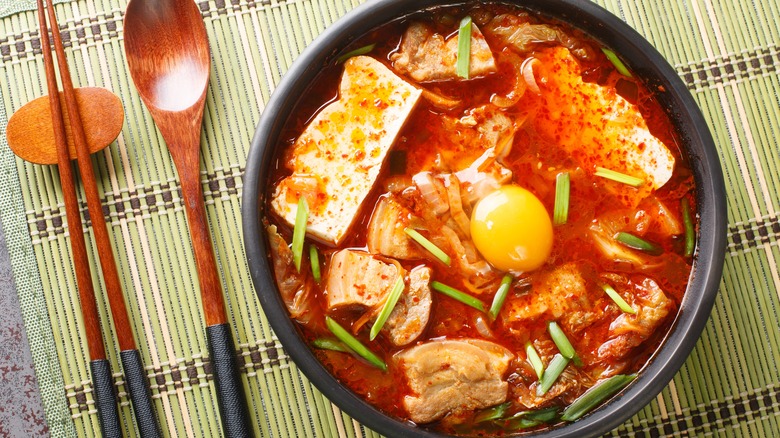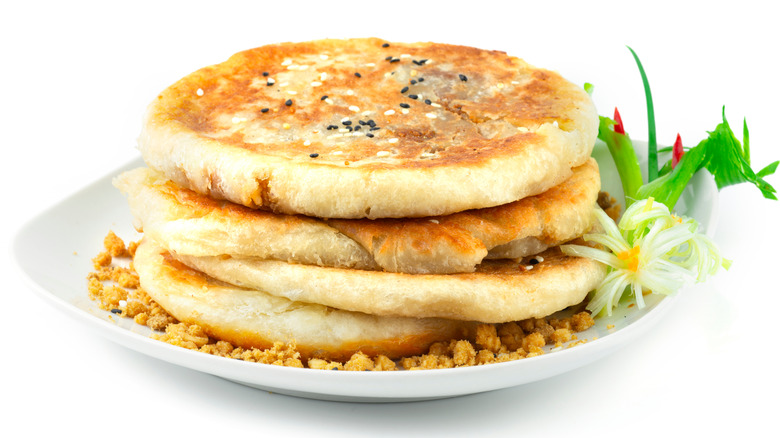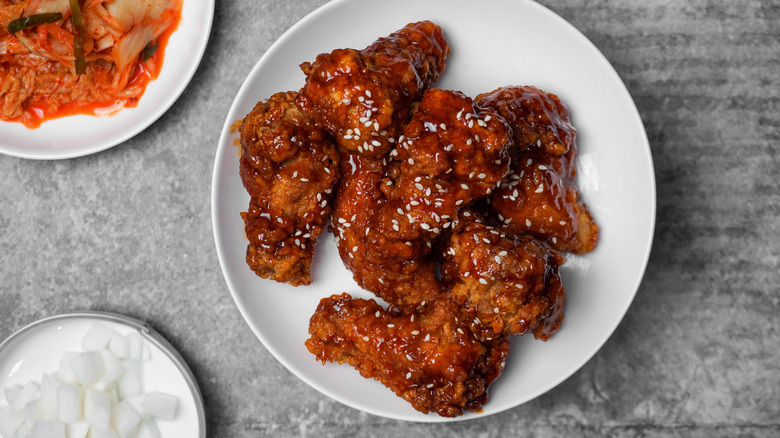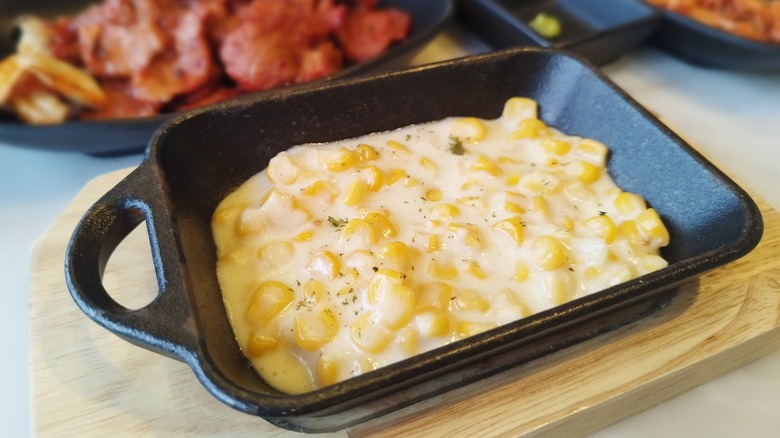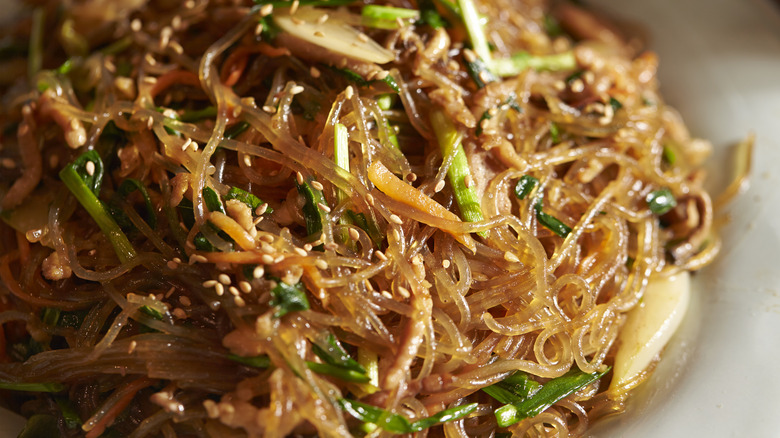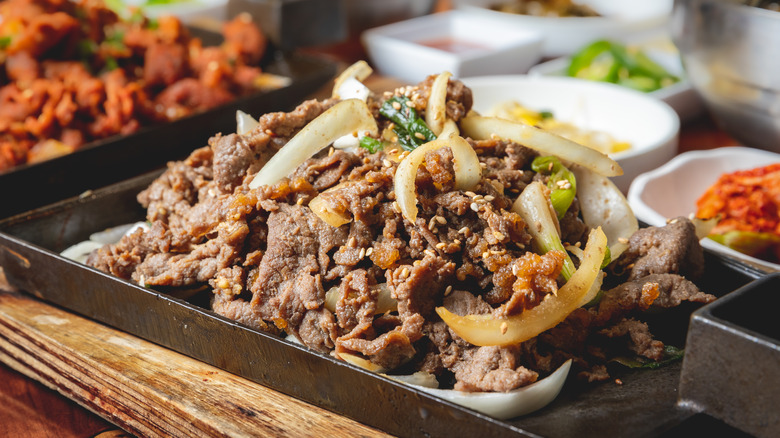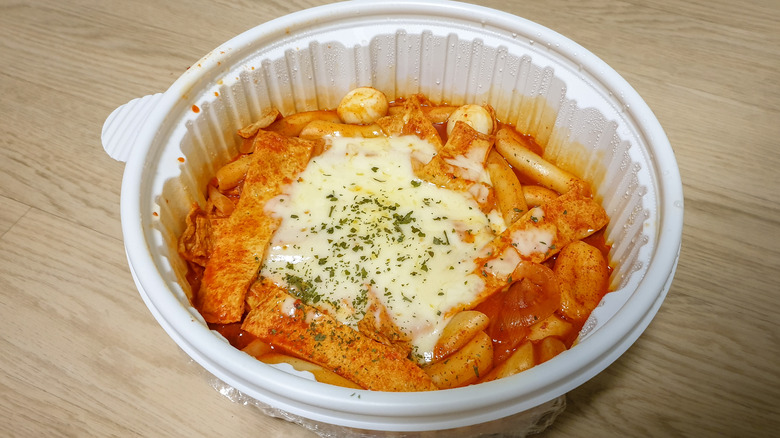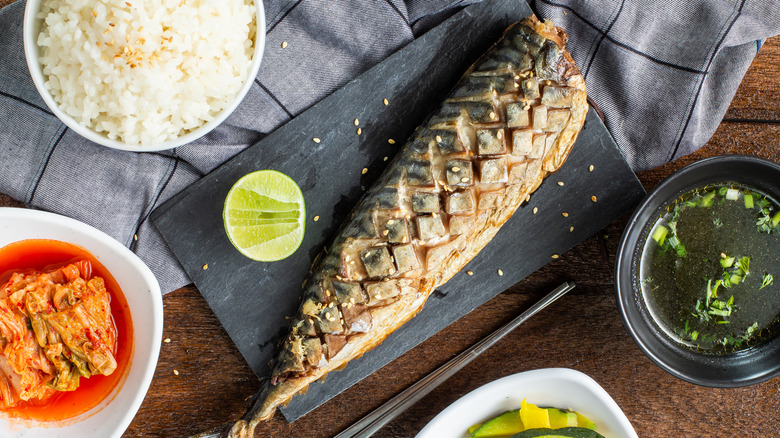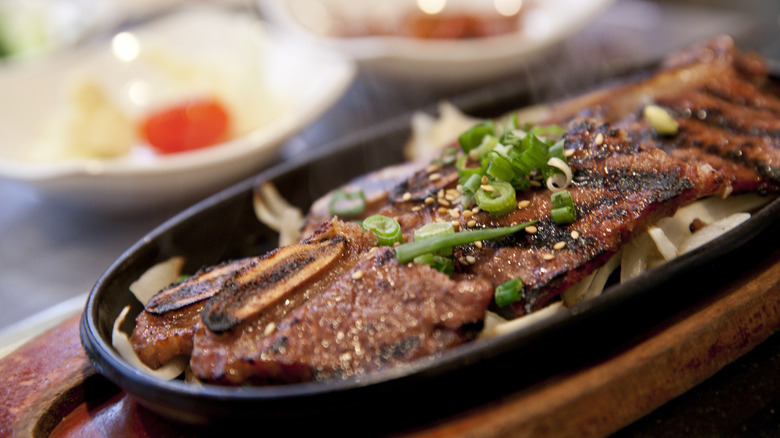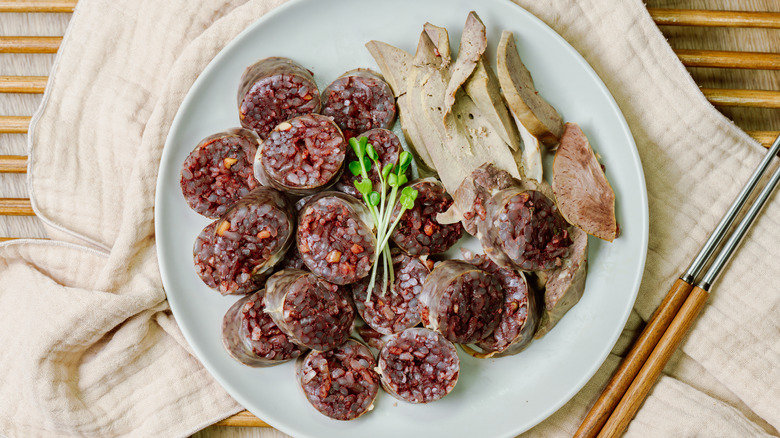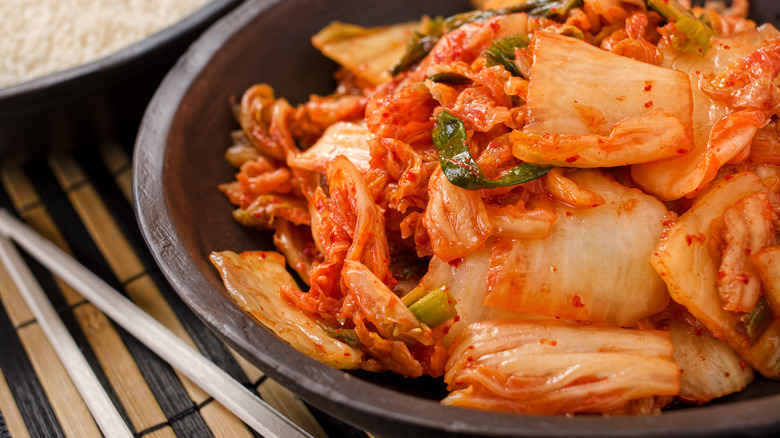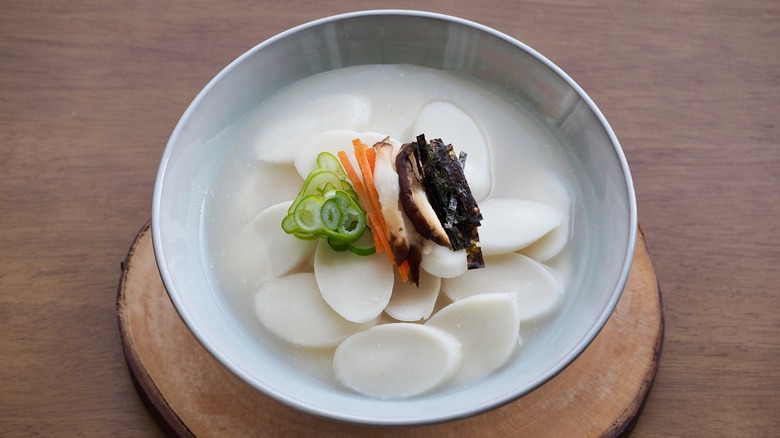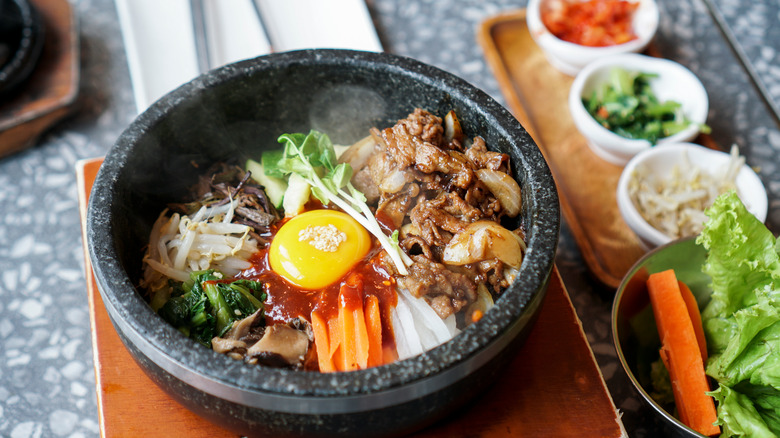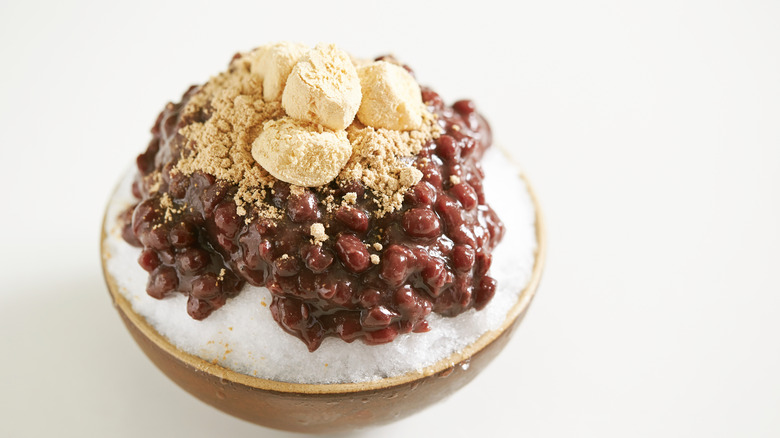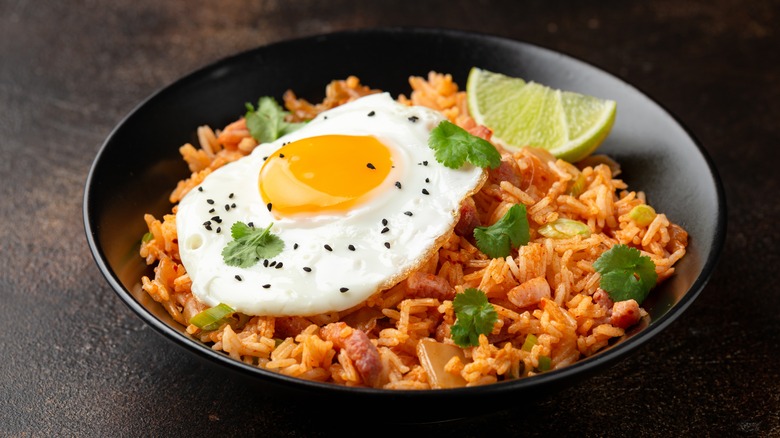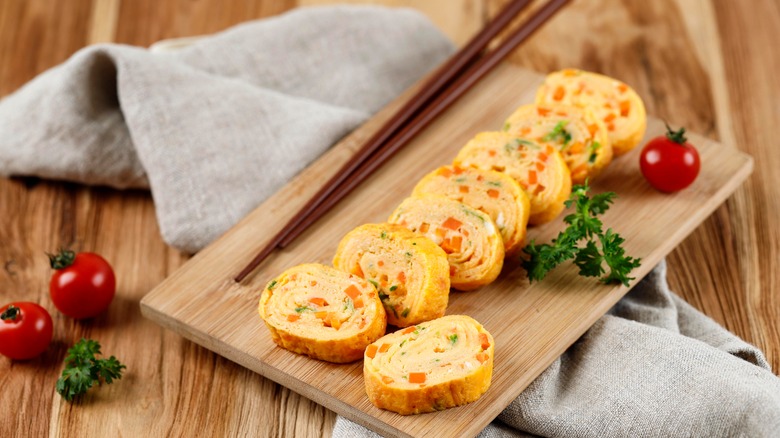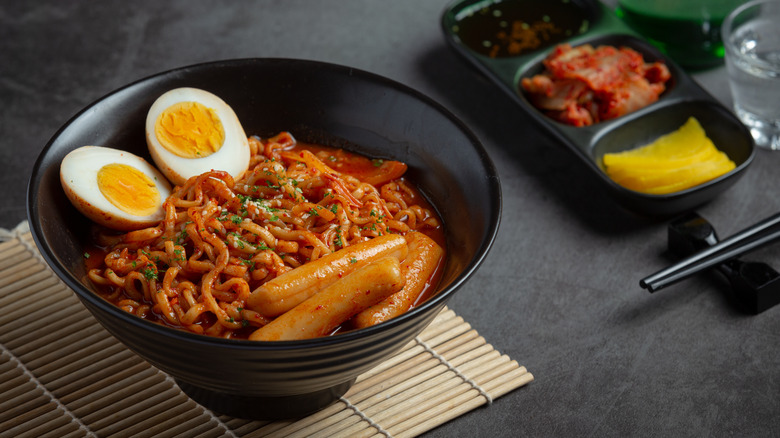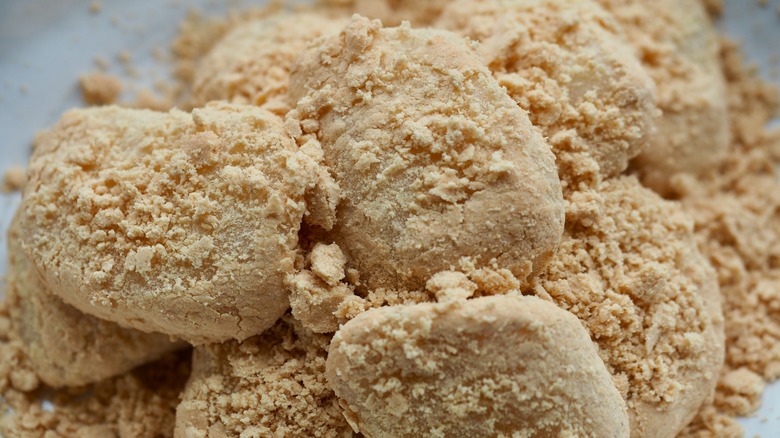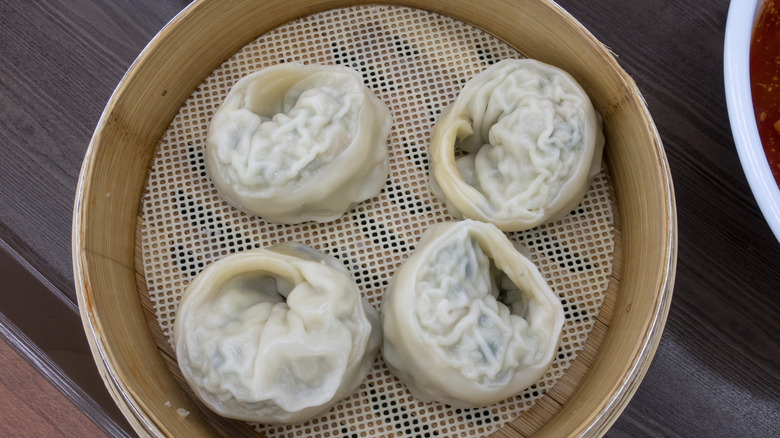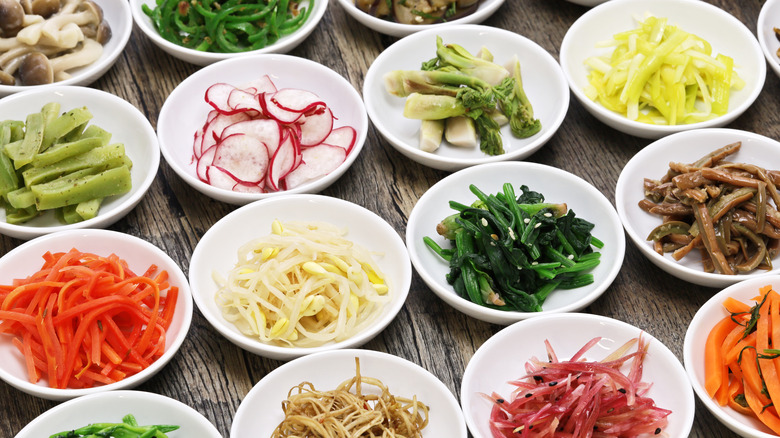26 Korean Dishes Everyone Needs To Try Once
Korean culture is on the rise; the country's film, television, and pop music have made themselves into American households with the crossover success of "Parasite," "Squid Games," B.T.S., BLACKPINK, and a steady stream of K-dramas and reality programs like Singles Inferno. But even before Netflix endowed Korean-originated programming with a category all its own, Korean food slipped into Western consciousness with crowd-pleasing creations like kimchi and bulgogi. Los Angele's Koreatown has carved out a micro-culture all of its own with several city blocks filled with Korean-owned businesses, largely restaurants, dedicated to keeping Korean culture alive and constantly evolving.
But like any cuisine, the barrier to entry might stop at untangling the various dishes on a Korean restaurant menu. Built around the cornerstones of white rice, fermented veggies, grilled meats, and gochujang, Korean food holds countless treasures. So, to help start your Korean food checklist, we've compiled a list of 26 Korean dishes to start your journey into the sweet and salty wonderland of Korean cuisine.
Pajeon
As in Japan and China, Korean cuisine also contains an irresistible savory pancake fried to crispy perfection. Pajeon or scallion pancakes are a satisfying side dish showcasing how to stretch a few ingredients into a plate worth fighting over.
Made simply of flour (wheat, rice, or both), scallions (or sometimes leeks), and water, pajeon is fried until delightfully crispy on either side and served with a simple soy-based sauce. Like many Korean dishes, some households throw leftover meats and seafood into the batter to bolster their pajeon, though the parred-down versions are just as delicious.
Kimbap
At first glance, Korean kimbap might look similar to sushi; however, these seaweed-wrapped goodies contain sticky rice, cooked eggs, acidic pickles, shredded fresh vegetables (like carrots), and a protein leftover from the night before's dinner.
Rarely does the Korean rendition of a seaweed wrap include the raw fish we associate with Japanese sushi, and the overall profile of kimbap rings is more hearty and pickle-driven than its Japanese counterpart. Often inside Korean lunchboxes, the simple but delicate snack can also be tracked down pre-made at the counter of most Korean markets for any kimbap-curious novices.
Ddukbokki
One of Korea's most versatile ingredients is its chewy, quick-to-cook rice noodles known as dduk (or tteok) can be found in soups, stir-fried dishes, threaded on skewers, and even on a tableside grill.
Ddukbokki (or tteokbokki), possibly the most popular dish using rice cakes, covers the log-shaped noodles (they also come molded into coins) in a spicy gochugaru sauce and is served along with a boiled egg. Intended as a side dish, a plate of ddukbokki also makes an easy, filling weeknight meal on the cheap.
Soondubu Jjigae
Served sizzling and a perfect match for a winter night, soondubu jjigae plays almost like the greatest hits of our favorite Korean staples; kimchi, soft tofu, gochujang, scallions, and of course a freshly cracked egg all go into one of the most emblematic Korean dishes of all time.
At once hearty and uncomplicated, find a clay pot of soondubu jjigae during the winter months to help wash away the chill and pair it with a piping pot of Korean barley tea.
Hodukk
A lesser-known treat from the seemingly endless catalog of Korean goodies is a sweet street food called hodduk. Filled with sugary treats like honey, cinnamon spread, sugared red bean paste, and so on, hodukks are handheld, single-serving pancakes structured similarly to a pupusa; dough encases the filling and is crisped in a frying pan on either side.
While frozen versions can be found at most Korean groceries, hunting down a fresh, handmade hodduk is worth the search.
Jjajangmyeon
A Korean and Chinese hybridization dating back to the 19th Century, jjajangmyeon marries Korean fermented soy bean sauce with chewy noodles into a dark brown (nearly black) sauce that gets a hit of stir-fried meat and vegetables before serving.
Visually distinct, the inky noodles are mixed with a deep black-colored, glossy sauce, unlike anything Western kitchens have to offer. But their ultra-savory, rich, and gently sweet flavor will win you over despite the noodle's initial stark appearance.
Korean fried chicken
Korean fried chicken, known for its audibly crunchy texture, often gets its big bite from a rice flour dredge before deep frying.
Though not always spicy, Korean fried chicken also frequently gets dipped in sweet and spicy sauces, mostly involving gochujang. Found mostly in Korean bars and restaurants specializing in Korean fried chicken, the dish's rising popularity has resulted in an American expansion of chains like Bonchon cropping up in cities around the nation.
Cheesy corn
A Korean bar crawl could hardly be called complete without an ooey, gooey plate of cheesy corn. Found mostly at Korean bars and snack spots (or Pochas), cheesy corn is the late-night craving you didn't know you had.
Featuring corn (more than likely canned) and easy-to-melt mozzarella cheese, the broiled corn dish finds a happy medium between mozzarella sticks and Mexican elotes; the only drawback to the Koreantown classic is resisting spooning a piping hot bite across your lips and burning the top of your mouth — a risk we'd happily take again any day.
Japchae noodles
Chances are you've encountered japchae noodles in the past, but you probably didn't know that the noodles' slick, slightly see-through surface is made from sweet potato starch.
The glassy noodles found in almost every Korean restaurant are tossed in sesame oil and mixed with cooked vegetables like mushrooms, carrot slivers, and spinach. Egg ribbons and little chunks of beef often finish japchae, and the dish is one of the simplest to assemble yourself at home.
Bulgogi
Another Korean dish common to Westerners is the country's equivalent to stir-fried beef or teriyaki, bulgogi, literally meaning "fire meat." This crowd-pleasing, sweet marinated sliced beef plate always contains soy sauce, something sweet (sugar, honey, or even shredded apples), sesame oil, onions, and garlic.
A perfect dish for anyone new to Korean food who might be overwhelmed with the cuisine's kaleidoscope of options, bulgogi tastes familiar but still boasts the cuisine's cornerstones.
Buldak Chicken
Not for the faint of heart, buldak chicken is one of those "it's-so-crazy-it-just-might-work" dishes we can barely wrap our head around no matter how many times we take down a pan of buldak chicken.
The super spicy chicken is topped with a healthy amount of cheese (usually mozzarella) and then capped off with chewy, dduk (or tteok) rice cake noodles before spending time under the broiler. The final dish is somewhere between a casserole macaroni and cheese and the hottest plate of wings you've had in a while.
Grilled or broiled salted mackerel
One of Korea's most elegant dishes, godeungeo gui, or salted cooked mackerel, is a dish that steps away from the sweet, saucy dishes of the Korean table and instead leans on a simple, perfectly cooked piece of mackerel.
The flaky, pleasurably oily white fish is lightly seasoned, heavily salted, and either grilled, pan-fried, or broiled until the skin bubbles and creates a yummy char. Served with lemons and a simple soy sauce, godeungeo gui is a healthy-ish dish that will surely satisfy you.
Pork bo ssam
Though Momofuku may have popularized and fancified pork bo ssam ("ssam" literally means "to wrap"), the boiled pork shoulder dish showcases one of our favorite elements of a Korean dinner — assembling our own bites — is one of the most universal Korean dishes.
Thinly sliced pork is served alongside wilted cabbage, kimchi, rice paper, and sauces so the diner can build a perfect little pork folder of food. As stunning as it is delicious, pork bo ssam is a salty classic to keep an eye out for.
Galbi
You've surely seen (and hopefully) tried Korea's grilled shortribs, or galbi (sometimes referred to as kalbi), a celebratory beef rib dish found at nearly every Korean BBQ restaurant.
The marinated sweet ribs are thinly sliced (sometimes even deboned) and served with a feast-worthy set of steamed rice, kimchi, and other banchan (small plates) should be a little sweet, a little salty, and extremely tender. If your plate of galbi is delivered with a pair of kitchen sheers, chances are you're in good hands.
Sundae
Maybe the most challenging of all the Korean foods on this list to Western tastes, sundae, or Korean blood sausage showcases beef or pork (sometimes both) blood into a sausage casing along with garlic, seasoning, and other aromatics.
A clever way to repurpose what could've been animal scraps, sundae, like chicken liver mousse, transforms offal into a dish synonymous with Korean street food. We especially like our sundae deep-fried into little fatty coins, but the most widespread version of the dish is simply boiled and sliced.
Kimchi
Though kimchi can even be found at non-Korean restaurants throughout America, the fermented, spiced vegetable dish probably comes in more varieties than you know of. Though the Napa cabbage rendition of the obligatory Korean side is sold at Western supermarkets, lesser-known variants include daikon radish, a whole cucumber, whole perilla leaves (sometimes called shiso), and so many more.
Traditionally family households swap their kimchi creations with one another so everyone's fridge can boast a healthy array of the time-consuming-to-make classic side dish.
Dduk guk
We love a meal intertwined with celebrating an annual holiday; thousands of times more enjoyable than a Thanksgiving turkey and so much healthier than Easter deviled eggs is Korea's signature dish meant to commemorate the lunar new year.
A sign of good luck, this comforting soup features coin-shaped dduk rice cakes, daikon radish, and braised beef (usually brisket). Topped with garnishes like egg ribbons, scallions, red pepper threads, and sesame seeds, dduk guk is the reined-in soup we look forward to every winter.
Bibimbap
For anyone who finds themselves eating alone on their lunch break, a dazzling, colorful bibimbap is the perfect pick-me-up between working hours.
Built on a foundation of steamed rice, bibimbap features segmented sections of meat, kimchi, and fresh veggies (often shredded carrots, sprouts, and mushrooms) and is topped with a sunny-side egg, spicy sauce, sesame seeds, and scallions. For extra oomph, try the crunchy-bottomed dolsot version, wherein the rice inside a clay pot gets cooked, so the bottom layer of the rice is crispy and toothsome.
Kalguksu
Much like America's reliance on chicken noodle soup when the common cold rolls around, Korea's kalguksu (literally meaning "knife-cut noodle") can ease the sniffles with each warming bite.
Made with both seafood or chicken, beef, or pork, kalguksu takes simple gluten-rich noodles, cuts them into lengthy strips, and boils them in a savory broth. Like many Korean dishes, the soup receives garnishes like scrambled eggs sliced into ribbons, scallions (green onions), kimchi, and chili flakes.
Bingsu
Though not a country where desserts reign supreme, the small handful of Korean-originated desserts are all show-stoppers in their own right. Perhaps the most stunning of the bunch is Korea's shaved ice wonder, bingsu.
Analogous to Japanese kakigori, Korea's bingsu features finely shaved ice (requiring a special piece of equipment), sweetened condensed milk, and a dizzying array of toppings such as fresh fruit, matcha, chocolate, and whipped cream. Both refreshing and decadent, binsgu can't be found just anywhere, so if you see a shop specializing in the icy treat, pull over.
Kimchi fried rice
One of our favorite aspects of Korean cuisine is how seamlessly leftovers are reinvigorated into show-stopping dishes. Kimchi fried rice or kimchi bokkeumbap tops the charts of meals made from yesterday's leftovers.
Implementing day-old cooked rice, kimchi bokkeumbap spices up the dish with gochujang, kimchi scraps, whatever meat you have around the house (even Spam), and egg. Easy to make but hard to perfect, kimchi fried rice would win over even the most rigid Korean food skeptic.
Gyeran Mari
Gyeran Mari, one of the hardest-to-nail Korean snacks, requires a gentle hand and patience to perfect a delicately rolled omelet. The striking little egg slices are served as exquisite little bites, as opposed to the gigantic American omelet, along with a larger meal.
Dotted with finely chopped vegetables and/or seaweed sheets, gyeran mari requires few ingredients but a well-practiced technique of folding the cooking egg in on itself while still inside the heated pan.
Jjapagrui
Something between a comfort food and a guilty pleasure, we've rarely encountered jjapaguri while entirely sober, and the cheap, heavy dish seems to almost be designed to soak up soju. A hybrid of two Korean instant noodle kits, jjapaguri combines Korea's Jjapaghetti (a jiangjiangmyeon-inspired instant ramen) and Neoguri (a spicy seafood instant ramen) into one rich dish.
Made popular by the 2019 film "Parasite," wherein the family includes high-quality cuts of beef in the low-brow dish, jjapaguri is impressive, irresistibly salty, and exactly what we crave a plate of jjapaguri after a night out at karaoke.
Injeolmi
In every cuisine, there are foods we're comfortable cooking at home, and there are the ones we relish when someone else takes on the labor for us. Even though we hope to keep growing every year inside our kitchen, we may still be decades away from making our own injeolmi or sweet rice cake.
Though most Westerners are familiar with Japanese mochi, Korea's similar injeolmi also contains sweet, glutenous rice flour that has been heated and worked into a manageable dough. Impossibly soft and dusted with mugwort or soybean powder, the sticky delicacies are reserved for celebratory events like weddings and birthdays.
Mandu
A Korean feast would be incomplete without the inclusion of a plate of dumplings or mandu. Like Japan's gyoza or China's potstickers, Korean mandu also folds a meaty farce mixture inside a tender dumpling skin.
Served pan-fried, boiled, or steamed, a perfect mandu's dumping skin should still be slightly toothsome but mostly slick, and the meaty interior should be lusciously juicy and well-seasoned. Served with a vinegary soy sauce dip, you can make dozens of dumplings ahead of time and store the goodies inside your freezer for when your next mandu craving strikes.
Banchan
Though not exactly a specific dish, Korea's banchan represents our favorite element of the country's dining culture. If you've ever treated yourself to a full-fledged Korean dinner, you know that upon ordering, diners are often brought several tiny plates of pre-meal snacks.
While kimchi technically counts as a banchan, its omnipresence sets it apart from the kaleidoscope of other Korean small plates. Literally translating to "side dish," Korean banchan can be comprised of fluffed egg, corn syrup-coated boiled potatoes, an acorn jelly molded like Jell-o, blanched spinach rehydrated with soy sauce, seasoned fish cake, and countless other ingredients.
